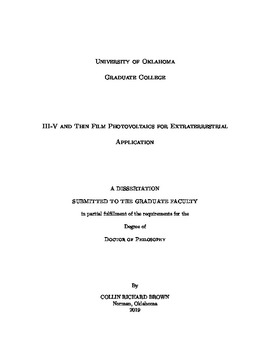| dc.description.abstract | Photovoltaic power is one of the few options available for electrical devices stationed outside of our atmosphere. As the satellite market turns to smaller satellites based on the CubeSat and SmallSat form factor, these limited size vehicles need enough power to complete their missions. Costs over mission lifetime also need to remain competitive when considering the typically shorter mission lifespan of these CubeSats. Increasing efficiency of current space photovoltaics while maintaining cost is one approach to this problem, though using flexible thin film solar arrays is an additional low-cost option that may still meet the power requirements under certain conditions.
Increasing the number of junctions in a multijunction solar cell is the direct approach to increase efficiency, and the quaternary GaInNAs has long been suggested as a fourth junction in the standard GaInP/GaAs/Ge cells, though material quality issues have prevented its penetration into the commercial sector. Here, optical GaInNAs samples carefully hydrogenated via a UV-activated process show evidence of impurity and defect passivation, completely removing the `s-shape' in the temperature dependent photoluminescence, while retaining the lower band gap that results from nitrogen incorporation. Radiative recombination is dominated by the free-excitonic transition, rather than emission due to carriers localized by non-ideal alloy fluctuations, as is common in this material system at low temperature. Density functional theory simulations show the elimination of N and Ga associated defect levels by hydrogenation, where the formation of N-H bonds act as donors. At higher hydrogenation concentrations, levels from Ga-H2-N complexes are pushed into the conduction band. These hydrogen complexes and the change in the band structure can explain the reduced emission observed from localized centers.
Two thin film PV technologies, Cu(In,Ga)Se2 (CIGS) solar cells and triple cation based perovskite solar cells, are both assessed under low-intensity-low-temperature (LILT) conditions consistent with orbits around Saturn, Jupiter, and Mars. Under these extreme conditions, evidence of unintentional barriers is observed in both material systems, though photovoltaic performance is relatively unaffected. In the CIGS devices, evidence of this photo-activated barrier appears consistent with metastable defect complexes and the CIGS/CdS interface. A similar interface appears responsible for the low fill factor in the perovskite solar cells at low temperature, where thermionic emission limits carrier extraction. Low intensity illumination reveals a recovery of the fill factor and efficiency, suggesting the potential of these devices in deep space conditions even in situations where sample degradation can occur in transit. CIGS devices studied here show no issues under thermal cycling measurements, and the perovskite devices demonstrated stability via temperature dependent photoluminescence, where no phase change was observed. Proton-irradiation experiments were performed on the CIGS devices, where degradation and subsequent self-healing from annealing conditions was observed. These results show promise for CIGS and Perovskite solar cells in space, individually and perhaps in tandem/multijunction applications.
Finally, InP based devices have shown greater radiation tolerance than other III-V materials, and the addition of quantum confined structures has also shown to increase this behavior. To further investigate this, Type II InP/InAlAs quantum well devices are grown by MOCVD, and investigated via photoluminescence, current density-voltage, external quantum efficiency, and photoreflectance measurements. Photovoltaic behavior is observed, and investigation into the various interface transitions is performed to better understand the physics in these devices. | en_US |
